Product or service
Simulator of Human Intestinal Microbial Ecosystem (SHIME®)
Dynamic in vitro simulators of the human digestion system provides detailed information on the fate of food (ingredients) during digestion and the associated changes in the human gut microbiota.
SHIME is a dynamic in vitro simulator model of the human digestion system. It allows the culturing of the complex intestinal microbial ecosystem over a longer period of time and under conditions representative for different intestinal regions. Moreover, as different segments of the gastrointestinal tract and the colon are being imitated, these model systems can provide detailed information of the fermentation profile, including the localization of the effect along the intestinal tract.
In addition, the system allows an improved realistic assessment of the pre- or probiotic properties of the target food or ingredients after 2 to 3 weeks of continuous administration of the product. Experiments with this length of time simulate the repeated ingestion of such products.
The SHIME can be operated to simulate a range of intestinal environments, including those of infants, adults, elderly and specific suboptimal conditions (pathogen infection).
Technical details
The SHIME® consists of a succession of five reactors, simulating the different parts of the human gastrointestinal tract. The first two reactors are of the fill-and-draw principle to simulate different steps in food uptake and digestion, with peristaltic pumps adding a defined amount of SHIME feed (140 mL 3x/day) and pancreatic and bile liquids (60 mL 3x/day), respectively to the stomach (V1) and small intestine (V2) compartment. The respective reactors are emptied after specified intervals.
The last three compartments simulate the large intestine. These reactors, with a constant volume and under pH control, are continuously stirred. Upon inoculation with faecal microbiota, these reactors simulate the ascending (V3), transverse (V4) and descending (V5) colon.
Environmental conditions in each section of the system are entirely computer-controlled. The TWINSHIME version available offers the possibility to run two experiments (typically the intervention and the control) in parallel.
Applications
- Probiotic effects of selected microorganisms
- Prebiotic effects of selected food ingredients or foods
- Shift in gut microbiota upon different dietary patterns
- Shift in gut microbiota upon antibiotic treatment
- Bioavailability of micro-nutrients/macronutrients
- Kinetics of nutrients/phytochemical metabolism by the gut microbiota
Complementary techniques
SHIME can be converted to M-SHIME by the addition of mucin-covered microcosms to the 3 colon regions. Bacteria which can adhere to the mucus layer will colonize the microcosms and create a mucus-compartment in the reactor.
By replacing half of the microcosms every three days, the intestinal replacement of the mucus layer is simulated, allowing continuous modelling of the mucosa compartment. Furthermore, adhered bacteria can be removed from the harvested microcosms, allowing the characterization of the adhered community.
Publications
Van den Abbeele P. et al. (2010) Microbial community development in a dynamic gut model is reproducible, colon region specific and selective for Bacteroidetes and Clostridium cluster IX. Appl Environ Microbiol. 76: 5237-5246
Van den Abbeele P. et al. (2012) Incorporating a mucosal environment in a dynamic gut model results in a more representative colonization by lactobacilli. Microb Biotechnol. 5(1):106-15;
Van den Abbeele P. et al. (2013) Butyrate-producing Clostridium cluster XIVa species specifically colonize mucins in an in vitro gut model. ISME J. 6(4):335-40
Sanchez-Patan, F et al. (2015). Comparative in vitro fermentations of cranberry and grape seed polyphenols with colonic microbiota. Food Chem. 183, 273–282.
Giuliani C. et al., (2016). Dietary supplement based on stilbenes: a focus on gut microbial metabolism by the in vitro simulator M-SHIME®. Food Funct. DOI: 10.1039/c6fo00784h.
